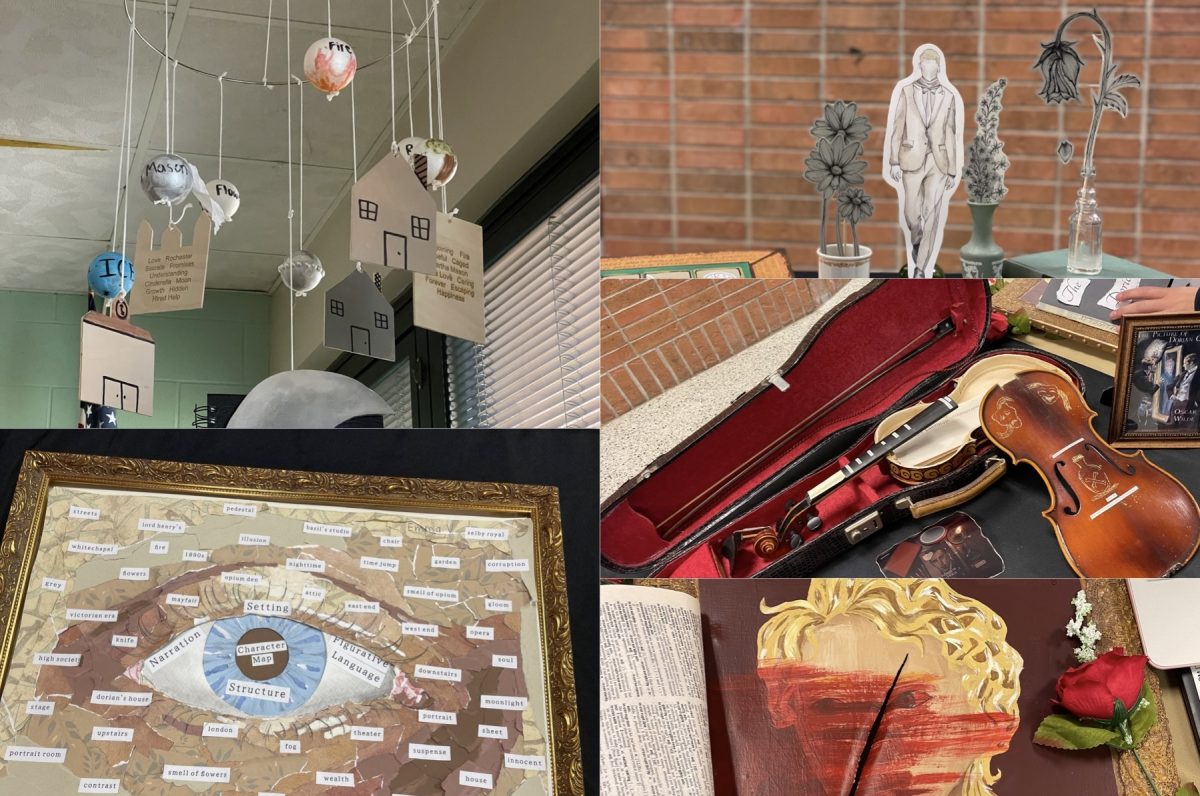Senior Paige Harsevoort has made book lovers everywhere tremble at the sight of her AP Literature project.
“My favorite part [of making my project] was painting the violin and taking the top of it off,” Paige said. “My least favorite part was cutting out quotes from my book because it felt like a crime.”
While cutting out words from a book isn’t technically a crime, it can sure feel like one, especially to those who go to great lengths to preserve their books.
The level of freedom that led Paige to cut into her book and also use a violin is rather rare in school projects, but the latest AP Lit project has given students just that.
In November, AP Lit students got into book clubs and read classic literature; on Dec. 11, they turned in a large project that encompassed different aspects of the book they read. Paige read The Picture of Dorian Gray by Oscar Wilde.
“I thought [the violin] would be an out-of-the-box way to symbolize the book, and I wanted to do more than just write about it,” Paige said. “So, I thought getting a violin would be cool.”
A key part of this project is that students can format the project however they want, which has created a vast variety of unique projects that differ from one another. This is the third year that AP Lit teacher Lisa Penninga has done this project; she especially loves how no two projects are the same.
Not only does this freedom make each project that Penninga grades more unique, but it also makes the assignment more fun for the students. All the different options allow them to choose what they want to do most, which makes them more devoted to their project.
“[The freedom given within this project] definitely allows for student joy and passion to come into their academic discourse,” Penninga said. “For the first time, I had students use the wood shop to create final pieces, which is so cool, and I have had sketches, paintings, dioramas, and recycled book art in so many cool ways. Students who are talented digitally can create such powerful slideshows, too. Both the physical and digital components help students to create a polished final product.”
Among the variety of books that students read is plenty of inspiration which expedites project ideas. Senior Jenna Lowell read Jane Eyre by Charlotte Brontë and found inspiration within the author’s writing style, and she was able to accurately portray that due to the independence with which she could create her project.
“In Jane Eyre, Charlotte Brontë employs a very unique writing style, one that I have never read before this book club,” Jenna said. “There are times throughout the story where Jane breaks the flow of the narration, and talks directly to the reader. This was the main inspiration for the theme of my scrapbook, so I tried to center it around these ‘Dear Reader’ moments.”
Jenna’s analysis of the book’s style led her to create a scrapbook for her project, which included all the needed components of the assignment in a creative, opportune format. However, one downside of her impressive choice was that it took up most of the weekend to create.
But, this was worth it to Jenna, as she wanted her work to truly be her best. In the end, she made a project that she was proud of and also thoroughly enjoyed making.
“If I had to choose, I would say that putting all the components of the scrapbook together was my favorite part; even though it took a while, I was super proud of the finished product,” Jenna said. “Overall, this has been one of my favorite projects that I have done throughout high school, and that is much in part due to the creative freedom that Penninga gave to us.”
From Paige’s violin to Jenna’s scrapbook, each student’s project was distinct to them while still providing insight into the structure of the book and representing the author’s purpose. Penninga also hopes students can understand characterization, setting, and point of view’s effect on the story.
As the class looks ahead to second semester, they can see all they have learned so far in the form of their projects. Penninga intends for her students to recognize that this project effectively applies everything they have spent the semester learning.
“Seeing the ‘fab five’ or the five focal areas we study come together is such a powerful way to head into second semester,” Penninga said, “and it really shows them they have learned to analyze instead of summarize. They recognize their ability to see complexity and depth in literature, which is so empowering for them.”




























































































